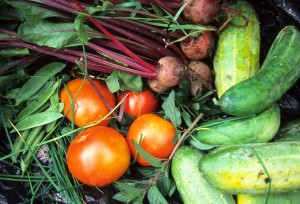
By Nathaniel Sillin
Have you ever thought about growing your own fruits and vegetables at home? For experienced gardeners, the cold months are when their imaginations get fired up; seed catalogs seem to blow in with the arctic blast, accompanied by companion mailings from gardening accessories and equipment retailers. But where can amateurs start?
To maintain a garden as a legitimate financial alternative to store-bought food, it’s important to understand the underlying costs involved. Some gardeners spend substantial bucks on fancy tools, equipment, gardening clothes, deluxe fertilizers or supplies, which sounds counter-intuitive to a money-saving alternative. Investing in home gardening requires frugal spending and a desire to learn – very few people wipe out their entire produce bill without a little preparation, knowledge and most important, trial and error.
There are plenty of studies on how much people are investing in home- and community-based gardens, but very few reliable guidelines on how much money you can actually save by gardening. That’s because it’s tough to generalize results based on geography, climate and skill sets.
Nevertheless, if you still want to get your hands dirty, here are some general steps to take before you dig in:
Harvest as much local gardening knowledge as you can. The word “local” is very important. Planning a home-based edible garden in a sunny West Coast backyard is very different than planting a series of clay pots on a Midwestern terrace. Start with a close look at your climate and growing conditions before buying anything.
Plant only what you’ll eat. If you want a salad garden, stick to lettuce that can be planted and harvested repeatedly in one season. Maybe you’ll also want to plant a tomato plant or two. If you generally buy a lot of a particular vegetable, try and grow that first. The more you want to eat the food you’re planting, the more interest you’ll take in making it a success.
Keep your first effort as inexpensive as possible. Generally, the cheapest way to grow plants is from seed you start growing indoors. Some people have special lights and shelving for indoor seed starting, but if you’re planning on only a few plants, it’s best to start modestly. Consult experts about the most effective and frugal way to start your desired plants from seed at home and set a growing schedule that culminates in actual planting outdoor. Sometimes it’s better to stick with a few borrowed or garage sale hand tools and recycled containers that will work just fine for seeding and drainage.
Keep learning as you go. When you start gardening, even if it’s only a pot or two where you’re growing from seed, start an annual garden journal that details what you’ve purchased (with prices), what’s worked well and all questions and answers you’ve gathered along the way. You might even discover new plants you’d like to grow next year. Re-reading your journal before you start your gardening planning in winter is a great way to shape your growing and cooking priorities for the coming year.
Bottom line: Homegrown food usually tastes better for two reasons – it’s fresher than anything you can buy and you have the pride of growing it yourself. However, making an economical home garden takes know-how, knowledge and as minimal initial investment as possible.
Nathaniel Sillin directs Visa’s financial education programs. To follow Practical Money Skills on Twitter: www.twitter.com/PracticalMoney.




